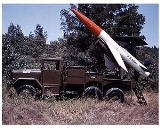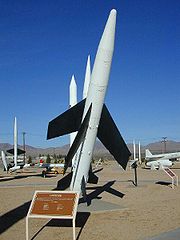
MGM-18 Lacrosse
Encyclopedia
The MGM-18 Lacrosse was a short-ranged tactical ballistic weapon intended for close support of ground troops.
Its first flight test was in 1954 and was deployed by the United States Army
beginning in 1959, despite being still in the development stage. The program's many technical hurdles proved too difficult to overcome and the missile was withdrawn from field service by 1964.
requirement for a short-range guided missile to supplement conventional field artillery. The Navy's Bureau of Ordnance issued contracts to both the Applied Physics Laboratory at Johns Hopkins University
and the Cornell Aeronautical Laboratory in September 1947, for the study of design aspects pertaining to this mission.
The missile system was named the Lacrosse because it employed a forward observation station which had a direct view of the target. The forward observation station was mounted on a jeep and after the missile was launched control was passed to the forward station for final guidance to the target. Hence the name Lacrosse which is how the game of Lacrosse is played with the ball being passed to players closer to the goal.
In 1950, the project was transferred from the Navy to the Army's Ordnance Corps and Redstone Arsenal
, pursuant to a policy giving the Department of the Army responsibility over all land based short ranged weapons. Cornell and Johns Hopkins continued with the project, with the former having primary responsibility for guidance systems design.
In 1955, the Glenn L. Martin Company was awarded contracts to participate in research and development and production. Martin would take over much responsibility for the project, as Cornell moved to work on expanding the missile's capabilities beyond the original requirements (particularly in the area of airborne control, funding for which was discontinued in 1959).
Early testing began in 1954 and production prototypes were available the next year. The difficulties encountered by the project are illustrated by the protracted design and testing periods, with the missile not entering into service until July 1959. Problems included reliability concerns and difficulties with guidance, particularly susceptibility to ECM jamming of the command guidance signals.
In 1956, the Federal Telecommunications Laboratory began work on a different guidance system, known as MOD 1, which would have improved Lacrosse’s performance with regards to electronic countermeasures. MOD 1, however, was terminated in 1959, causing the United States Marine Corps to withdraw their participation in the project. The first units received Lacrosse in 1959, though the system would continue to be in need of development and refinement.
Nearly 1,200 Lacrosse missiles were produced and deployed at a cost of more than US$
2 billion in 1996 dollars (excluding the cost of the nuclear warheads).

Its first flight test was in 1954 and was deployed by the United States Army
United States Army
The United States Army is the main branch of the United States Armed Forces responsible for land-based military operations. It is the largest and oldest established branch of the U.S. military, and is one of seven U.S. uniformed services...
beginning in 1959, despite being still in the development stage. The program's many technical hurdles proved too difficult to overcome and the missile was withdrawn from field service by 1964.
Development
The Lacrosse project began with a United States Marine CorpsUnited States Marine Corps
The United States Marine Corps is a branch of the United States Armed Forces responsible for providing power projection from the sea, using the mobility of the United States Navy to deliver combined-arms task forces rapidly. It is one of seven uniformed services of the United States...
requirement for a short-range guided missile to supplement conventional field artillery. The Navy's Bureau of Ordnance issued contracts to both the Applied Physics Laboratory at Johns Hopkins University
Johns Hopkins University
The Johns Hopkins University, commonly referred to as Johns Hopkins, JHU, or simply Hopkins, is a private research university based in Baltimore, Maryland, United States...
and the Cornell Aeronautical Laboratory in September 1947, for the study of design aspects pertaining to this mission.
The missile system was named the Lacrosse because it employed a forward observation station which had a direct view of the target. The forward observation station was mounted on a jeep and after the missile was launched control was passed to the forward station for final guidance to the target. Hence the name Lacrosse which is how the game of Lacrosse is played with the ball being passed to players closer to the goal.
In 1950, the project was transferred from the Navy to the Army's Ordnance Corps and Redstone Arsenal
Redstone Arsenal
Redstone Arsenal is a United States Army base and a census-designated place adjacent to Huntsville in Madison County, Alabama, United States and is part of the Huntsville-Decatur Combined Statistical Area...
, pursuant to a policy giving the Department of the Army responsibility over all land based short ranged weapons. Cornell and Johns Hopkins continued with the project, with the former having primary responsibility for guidance systems design.
In 1955, the Glenn L. Martin Company was awarded contracts to participate in research and development and production. Martin would take over much responsibility for the project, as Cornell moved to work on expanding the missile's capabilities beyond the original requirements (particularly in the area of airborne control, funding for which was discontinued in 1959).
Early testing began in 1954 and production prototypes were available the next year. The difficulties encountered by the project are illustrated by the protracted design and testing periods, with the missile not entering into service until July 1959. Problems included reliability concerns and difficulties with guidance, particularly susceptibility to ECM jamming of the command guidance signals.
In 1956, the Federal Telecommunications Laboratory began work on a different guidance system, known as MOD 1, which would have improved Lacrosse’s performance with regards to electronic countermeasures. MOD 1, however, was terminated in 1959, causing the United States Marine Corps to withdraw their participation in the project. The first units received Lacrosse in 1959, though the system would continue to be in need of development and refinement.
Nearly 1,200 Lacrosse missiles were produced and deployed at a cost of more than US$
United States dollar
The United States dollar , also referred to as the American dollar, is the official currency of the United States of America. It is divided into 100 smaller units called cents or pennies....
2 billion in 1996 dollars (excluding the cost of the nuclear warheads).


